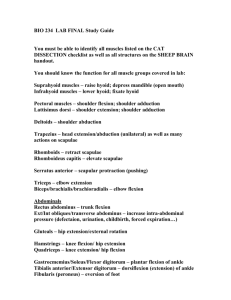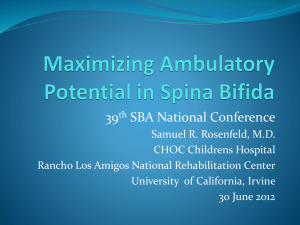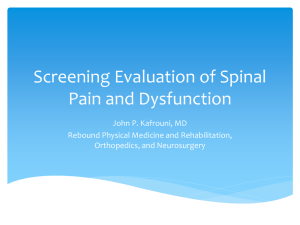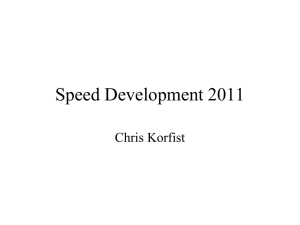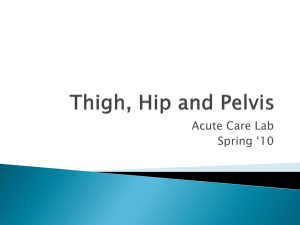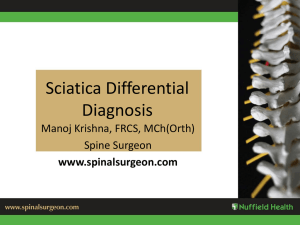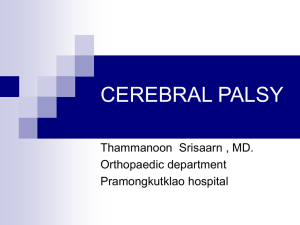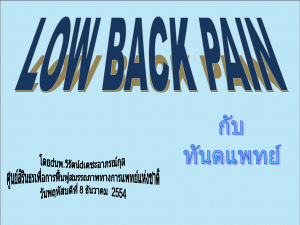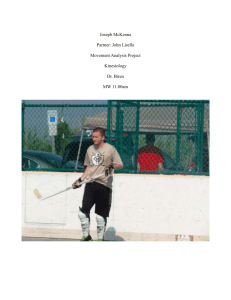Clients_with_Orthope..
advertisement
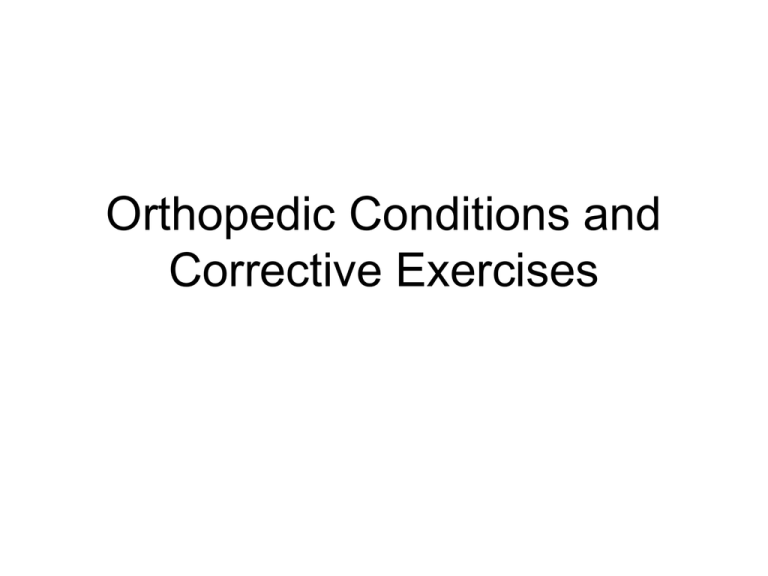
Orthopedic Conditions and Corrective Exercises Back and Spinal Cord • The biggest musculoskeletal issue you will face as a trainer • Most of your clients will currently have, or have had, back pain • Why: – People are overweight and out of shape – People sit on their butts all day – No Core Strength – Limited Flexibility – Poor Posture – Bad Biomechanics Low Back Pain (LBP) • One of the leading causes of pain and disability • Low back pain is a generalized term involving several different diagnoses, including but not limited to: – Disc dysfunction – Muscle strain – Spondylolisthesis – Spondylolysis – Spinal stenosis – Sciatica Intervertebral Disk Anatomy • Soft “cushion like” structure that separate each vertebrae • Purpose – Act as shock absorbers between the vertebrae – Function as ligaments by holding the vertebrae together – Act as joints allowing the spine mobility in all three planes • The disc is comprised of two primary elements – Nucleus Pulposus – Anulus Fibrosus • Jelly doughnut Intervertebral Disk Anatomy • Nucleus Pulposus – A soft, gel-like inner substance contained within the anulus fibrosus – Consistency of toothpaste • Anulus Fibrosus – Tough, outer ring that surrounds and contains the nucleus pulposus Intervertebral Disk Video • http://www.youtube.com/watch?v=kcwaOT put_o&feature=related Bad Biomechanics • Disc pressure increases –33% while sitting –33% while standing when slightly bent forward –45% while sitting when slightly bent forward –52% while standing when bent far forward –63% while sitting when bent well forward Movement Effects • During Flexion – Anterior portion of annulus fibrosis is compressed – Annulus fibrosis bulges anteriorly – Posterior portion is stretched • i.e., rubber ball between wood blocks • Under Compression – Nucleus pulposus distributes pressure in all directions to annulus fibrosis – Pressure is transmitted to the vertebral bodies – Under high compressive forces DISK WILL RUPTURE! Herniated Disk • Also called protruding, bulging, ruptured, prolapsed, slipped, or degenerated discs • Part of the nucleus pulposus makes its way through the outer anulus fibrosus, resulting in inflammation; this inflammation irritates the spinal nerve roots • Symptoms – Back and neck pain, tingling or numbness in the glutes, legs or feet, muscle weakness • When a client has a herniated disc, he or she should seek medical treatment Back Rehabilitation • Surgical Treatments – Laminectomy – Artificial Disk Replacement • Non-Surgical Treatments – Rehabilitation Exercises – Injections • Cortisone may help reduce swelling and inflammation of the nerve roots, allowing for increased mobility. These injections are referred to as epidurals or nerve blocks. Lumbar Laminectomy Video • http://www.youtube.com/watch?v=EvQPZx Xr3Rs Artificial Disk Replacement Video • http://www.youtube.com/watch?v=dLhUJl8 guA8&NR=1 Preventing Disk Herniations • Proper lifting techniques when picking objects from the floor • Maintaining a healthy weight • Practicing good posture when walking, sitting, standing, and sleeping • Sitting with your feet flat on the floor (not crossed) • Sleeping on a firm mattress • Avoid wearing high-heeled shoes Preventing Disk Herniations • Physical activity is key • Consistent and rational exercise • Core stability and strength • Flexibility • Accident prevention – is your body prepared for the activity you are about to do? Herniated Disk Exercise Guidelines • Movement Contraindications – Lumbar flexion • Avoid lumbar flexion to prevent the posterior protrusion of the disc material – Lumbar rotation • Exercise Contraindications – Sit-up’s, barbell back squats, stiff-leg deadlifts, bent-over rows, supine leg lifts, trunk rotations (i.e., chops), knee-to-chest stretch, stiff-leg toe touch, superman’s, good morning’s, bicycle riding and Spinning due to possible increased flexion with forward lean Herniated Disk Exercise Guidelines • Obtain medical clearance • Begin with one set of 10–15 repetitions, and progress to 3 sets of 15–20 • Exercise Indications – Drawing-in, chin tucks, posterior pelvic tilts, supine bridge on floor or SB, quadruped opposite-armopposite-leg, kneeling hip flexor stretch, SB against the wall squat, walking, aquatics – SB stabilization • Draw-in with 90 degree angle at both the hip and knee and thighs should be parallel with the floor when seated on the ball • Raise and lower one foot at a time • Alternating heel raises Back Strain • Strains to the muscles of the lumbosacral spine are common, and may have a variety of causes including direct trauma and overuse • Retraining muscles to function in their designed manner will enable the muscle to work more efficiently • Movement and exercise restriction is highly dependent on the muscle that has been strained • For example: If erector spinae muscles have been strained, lumbar extension exercises and exercises requiring isometric contraction (bentover DB row) should be avoided during the early phases of tissue healing Back Strain Exercise Guidelines • Movement Contraindication –Passive Lumbar Flexion (during inflammatory phase) –Active lumbar extension (during inflammatory phase) •Exercise Contraindication –Barbell back squat, stiff-leg deadlift, knee-to-chest stretch, supine leg lifts, bent-over rows •Exercise Indication –None during inflammatory phase, progressing to gentle flexion stretching, followed by extension strengthening –Posterior pelvic tilts, quadruped opposite-armopposite leg, supine bridge on floor or SB Spondylolisthesis • Spondylo means vertebrae • Listhesis means forward slippage • Spondylolisthesis is a forward slippage of one vertebra on another Spondylolysis • A spondylolysis occurs when there is a fracture, found in a region of the vertebrae called the pars interarticularis • The pars interarticularis connects the vertebral body in front with the vertebral joints behind Spondylolisthesis and Spondylosysis Exercise Guidelines • Obtain medical clearance • Strengthen the muscles that insert on the spine • Spinal stabilization to achieve ‘‘core stability’’ is a key component • Avoid exercises involving lumbar extension (stiff-leg deadlifts and barbell back squats) – Places stress on pars interarticularis and may worsen condition • Most abdominal crunches are appropriate Spondylolisthesis and Spondylosysis Exercise Guidelines • Movement Contraindication – Lumbar extension • Exercise Contraindications – Barbell back squat, deadlift, stiff-leg deadlift, standing DB or BB shoulder press, bent-over rows, trunk extensions (superman) • Exercise Indications – Begin with one set of 10–15 repetitions, and progress to 3 sets of 15–20 Spondylolisthesis and Spondylosysis Exercise Guidelines • Exercise Indications – Kneeling hip flexor stretch-very important to maintain neutral pelvic spine in order to eliminate hyperextension of the spine – Supine hamstrings stretch using a towel – Prone quadriceps stretch- place a rolled towel can under the distal thigh to create an increased stretch – Iliotibial band stretch – Posterior pelvic tilts – SB crunch – Quadruped drawing-in Spinal Stenosis • Stenosis means narrowing • Spinal stenosis is a narrowing of the spinal canal, which places pressure on the spinal cord • Symptoms are pain, weakness, or numbness in the legs, calves or buttocks • Individuals should seek Physical Therapy to help stabilize the spine, build endurance and increase flexibility Sciatica • Inflammation of the sciatic nerve • Sciatic nerve originates in the lumbar spine and travels into the thigh. Provides motor innervation to the hamstrings and all of the muscles in the leg and the foot. • Causes – Herniated disk (most common), pregnancy, spinal stenosis, spondylolisthesis, piriformis syndrome • Symptoms – Cramping of the thigh, shooting pain from the glutes down the leg, tingling, or pins-and-needles sensation in the legs and thighs, a burning sensation in the thigh Sciatica Exercise Guidelines • Obtain medical clearance • Most physical therapy programs will be tailored to address the underlying cause of the person’s sciatic pain, such as a herniated disc or piriformis syndrome • Doing the wrong type of exercise can worsen the sciatic pain, so it is important to get an accurate diagnosis prior to starting an exercise program Shoulder • The shoulder has the greatest range of motion of all joints in the body –Higher injury risk • Relationship between the scapula and humerus is key Shoulder Impingement Syndrome • Also known as rotator cuff tendonitis or bursitis • It is the pinching of the supraspinatus, the long head of the biceps tendon or subacromial bursa under the acromial arch • What not to do: – Anything overhead – Most “pressing” exercises – Anything heavy – Be wary of “pulling” exercises • What to do: – Focus on the specific scapular and rotator cuff muscles to re-establish shoulder stability – Gradually move back into general exercise program once pain subsides Shoulder Impingement Exercise Guidelines • Movement Contraindication – Overhead with internally rotated shoulder • Exercise Contraindications –Overhead DB or BB shoulder press in the frontal plane, lateral raise in the frontal plane, upright row, incline BB bench press, BB bench press, doorway pec stretch (abducted shoulders and 90 degrees of elbow flexion), dips, behind-the neck exercises, DB pull-overs Shoulder Impingement Exercise Guidelines • Exercise Indications – 1-3 sets of 10-15 repetitions – Light weight 0-5 pounds • Scapular stabilizing exercises – Tubing rows, push-up plus, DB shoulder shrugs, tubing shoulder extensions (swimmers) • Rotator cuff exercises – External and internal rotation with tubing, DB scaption Hip Replacement • Also known as hip arthroplasty • Total hip arthroplasty movement restrictions include the following for 10-12 weeks after surgery – No hip flexion greater than 90 degrees – No hip adduction past neutral – No twisting or pivoting the hip medially or laterally – No kneeling – Do NOT cross legs at the knees or ankles when sitting, standing, or lying down • Avoid high impact activities-running and jumping Hip Replacement Exercise Guidelines • Exercise Contraindications –Hip adduction machine, cable chops, piriformis stretch, hip abductor stretch •Exercise Indications –SB against-the-wall squats, calf raises, dorsiflexion (heel raises), swimming, walking, Elliptical trainer, heel slides, quad sets, glute sets (isometrically contracting glutes), recumbent bike Hip Replacement Exercise Guidelines Heel slide • Sit on a firm surface with your legs straight in front of you. • Slowly slide the heel of your affected leg toward your buttock by pulling your knee to your chest as you slide. • Return to the starting position. • 3 sets of 10 repetitions Quadriceps isometrics (Quad Set) • Sit on the floor with your affected leg straight and your other leg bent • Press the back of your knee into the floor by tightening the muscles on the top of your thigh. • Hold this position 10 seconds • 3 sets of 10 repetitions Anterior Cruciate Ligament Reconstruction • Exercises following ACL reconstruction are an extremely important part of a person’s rehabilitation • The function of the ACL is to control knee motion and provide proprioceptive feedback • The ACL limits anterior tibial translation and rotation relative to the femur ACL Reconstruction Exercise Guidelines • Movement Contraindication – Open knee movements less than 45 degrees of knee flexion • Exercise Contraindications – Leg extension performed from greater than 90 degrees of knee flexion to greater than 45 degrees of knee extension • Exercise Indications –SB Leg curls, step-up’s, SB squats against the wall, quad sets, heel slides, wall squat with ball squeeze (hip adduction), step-up’s, lunges, single-leg balance
